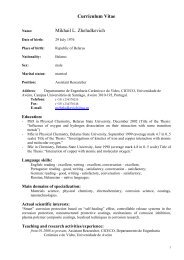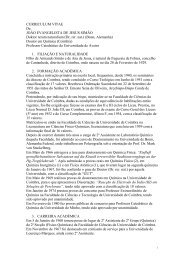XII Iberian Meeting of Electrochemistry XVI Meeting of the ...
XII Iberian Meeting of Electrochemistry XVI Meeting of the ...
XII Iberian Meeting of Electrochemistry XVI Meeting of the ...
Create successful ePaper yourself
Turn your PDF publications into a flip-book with our unique Google optimized e-Paper software.
<strong>XII</strong> <strong>Iberian</strong> <strong>Meeting</strong> <strong>of</strong> <strong>Electrochemistry</strong> & <strong>XVI</strong> <strong>Meeting</strong> <strong>of</strong> <strong>the</strong> Portuguese Electrochemical Society PD 01<br />
In-situ study <strong>of</strong> corrosion morphology <strong>of</strong> a duplex stainless<br />
steel in a concentrated LiBr solution and in an impure<br />
phosphoric acid solution by confocal laser scanning<br />
microscopy (C LSM)<br />
R. Leiva-García 1 , M.J. Muñoz-Portero 1 , J. García-Antón 1<br />
1<br />
Univ. Politécnica de Valencia, Ingeniería Electroquímica y Corrosión (IEC), Dep. Ingeniería<br />
Química y Nuclear, Camino de Vera s/n, 46022 Valencia, Spain.<br />
jgarciaa@iqn.upv.es<br />
Corrosion has been mainly studied using large-scale experiments. However, corrosion<br />
mechanisms occur on a smaller scale. Therefore, it can be useful to develop smaller<br />
scale methods and experimental methodologies. In this way, it will be possible to study<br />
reduced surfaces. The aim <strong>of</strong> this work is <strong>the</strong> study <strong>of</strong> <strong>the</strong> corrosion morphology <strong>of</strong> a<br />
duplex stainless steel (UNS 1.4462) in a concentrated aqueous LiBr solution (992 g/L)<br />
and in an impure phosphoric acid solution, containing chlorides and sulfates.<br />
The electrochemical techniques used were cyclic potentiodynamic curves and<br />
galvanodynamic curves. Tests were carried out in a minicell developed by this research<br />
group. This cell can be put in <strong>the</strong> stage <strong>of</strong> a confocal laser scanning microscope. In this<br />
way, <strong>the</strong> in-situ observation <strong>of</strong> <strong>the</strong> corrosion process at microscopic scale is possible. All<br />
<strong>the</strong> tests were made at 25 ºC.<br />
The LiBr solution is an aggressive solution that provokes localized corrosion in <strong>the</strong><br />
duplex stainless steel. During <strong>the</strong> potentiodynamic curves, pits appear in <strong>the</strong> electrode<br />
surface when <strong>the</strong> pitting potential is reached. These pits grow until affect <strong>the</strong> entire<br />
electrode surface. When this growth is observed at higher magnifications (200x and<br />
500x), <strong>the</strong> formation <strong>of</strong> new small pits is observed in <strong>the</strong> unaffected area (covered with<br />
<strong>the</strong> corrosion product) closed to <strong>the</strong> corrosion front. Then, this corrosion front reaches<br />
<strong>the</strong> pits and <strong>the</strong> observed surface ends completely damaged. In <strong>the</strong> case <strong>of</strong> <strong>the</strong><br />
galvanodynamic curves, a pit appears in <strong>the</strong> electrode surface when <strong>the</strong> pitting potential<br />
point is reached and it goes growing in a sequential way with <strong>the</strong> increase <strong>of</strong> <strong>the</strong> current<br />
density.<br />
With regard to <strong>the</strong> impure phosphoric acid solution, <strong>the</strong> potentiodynamic and<br />
galvanodynamic tests indicate that corrosion <strong>of</strong> duplex stainless steel is generalized in<br />
this medium. The images obtained at different magnifications (100x - 500x) show how<br />
<strong>the</strong> grain boundary <strong>of</strong> <strong>the</strong> tested stainless steel goes being revealed with <strong>the</strong> increase <strong>of</strong><br />
<strong>the</strong> current density. Despite <strong>of</strong> <strong>the</strong> presence <strong>of</strong> impurities, <strong>the</strong>ir concentration is not<br />
critical to produce a localized corrosion attack.<br />
Therefore, <strong>the</strong> developed minicell is useful to study <strong>the</strong> morphological differences<br />
among different kinds <strong>of</strong> corrosion attack at microscopic scale.<br />
Acknowledgments: We wish to express our gratitude to MICINN (CTQ2009-07518), to F EDER, to<br />
MAEC (PCI Mediterraneo C/8196/07, C/018046/08, D/023608/09) for <strong>the</strong>ir financial support and<br />
to Dr. Asunción Jaime for her translation assistance.<br />
September, 811, 2010. ISEL - Lisbon 83








